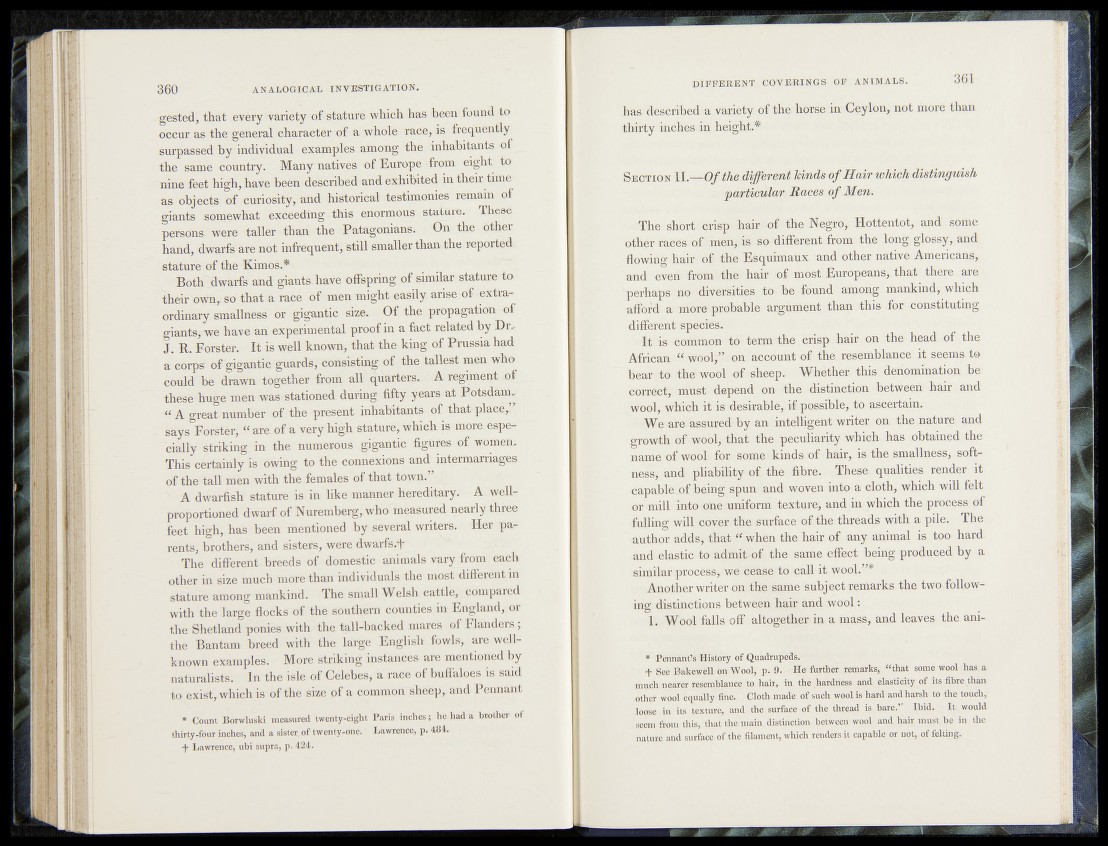
gested, that-.©very variety of statute which has been found to
occur as the general character of a whole raceyfe frequently
surpassed by individual examples among the inhabitants of _
the same country. Many natives of Europe -from eight to
nine feet high, have been described and exhibited in their time-
as objects of curiosity, and historical testimonies remain of
giants somewhat exceeding-this enormous stature. These
persons were taller than the Patagonians. On the other
hand, dwarfs are not infrequent, still smaller than the reported,
stature of the Kimos.*
Both : dwarfs and giants, have offspring of similar stature to
their own,, so that a race of men might easily arise of extraordinary
smallness or gigantic size. Of the propagation of
giants, we have an experimental proof in a fact related by Dr<
J. R. Forster. It is well known, that th e king of Prussia had
a corps of gigantic guards, consisting of the tallest men who
could be drawn together from all quarters. A regiment of
these huge men was stationed during fifty years at Potsdam.
“ A great number of the present inhabitants of that-placeJT I
says Forster; “ are.of a very high stature, which is more especially
striking in the numerous gigantic figures of women;
This certainly is owing to the connexions and intermarriages
of the tall men with the females of that town.”
A dwarfish stature is in like manner hereditary. A well-
proportioned dwarf of Nuremberg, who measured nearlythree
feet high, has been mentioned by several writers. Her parents,
brothers, and sisters, were dwarfe.t
The different , breeds of. domestic animals vary from each
other in size much more than individuals the most different in
stature among mankind. The small Welsh cattle, compared
with the large flocks of the southern counties in England, or
the Shetland ponies with the tall-backed mares ©f Flanders;
the Bantam breed with the large English fowls, are well-
known examples. More striking instances are mentioned by
naturalists. In the isle of Celebes, a race of buffaloes is said
to exist, which is of the size of a common sheep,, and Pennant
* Count Borwluski measured twenty-eight Paris inches ? he had a brother of
thirty-four inches, and a sister, of twenty-one. Lawrence, p. 484.
-Jr Lawrence, ubi supra, p. 424.
D IF FER EN T COVERINGS OF ANIMALS. 3 6 1
haé describedvàr vhrifety of the horse in Cuylon, not more than
thirty mebes-irc <hqighjt.#
S e c t io n I I .— O f the different hinds o f Hair which distinguish
. particular Races o f Men.
The short crisp4 hair of the Hottentot, and some
other races of men, is-«©- different from the long glossy, and
flowing hair ofj||$b Esquimaux :ànd other native Americans,
and even* from the hair of mifekEuropeans, that there are
v perhaps'no diversities to be jàu n d s mankind, which
afford a more probable argument than this for constituting
different 'species.* n ‘1
It is common to term the crisp hair , on th e head of^thc
African “ wool;”_on account ©f ihe^ièsem^lance i t seems to
bearrfo th^wool of sheep;«* Whether: t|is, denomination be*
correct;' must depend on the distinction, between4 hair and
wool, which it is desirable, if.poa»btè, t<^a$ep^afq.
We are assured*iy=an intelligent writer on the nature gnff
growth of wool, that the peculiarity which., has obtained the
name of wool for isqm^tkinds of hair, is, the ,smalli|J|ss, softness;
and pliability of the fibre. These qualities render .it
capablejof being spun- and woven into a cjqjdi, which will, felt
or mill into one uniform texture; and in which the prqcesarof
fulling will cover the surface of .the threads with a pile. The
author adds, that “ when the hair of - any animal is too hard
and elastic to admit-of the same effect hieing produced by a
similar process, we cease to call it wook”^;
Another writer on the same subject remarks the two following
distinctions between hair and wool .:; 1
| p Wool falls off altogether in a mass, and leaves,, the ani-
* Pennant’s History of Quadrupeds.
f See Bakewell on Wool, p. 9. He further remarks, “ that some wool has a
much nearer resemblance to hair, in the hardness and elasticity of ..its fibre than
Other wool equally fine. Cloth made of such wool is hard and harsh to the touch,
l00se in its texture, and the surface of the thread is bare.” Ibid. . It would
seem from this,' that the main, distinction- between wool and hair must be. in the
nature and surface of the filament, which renders it capable or not, of felting.